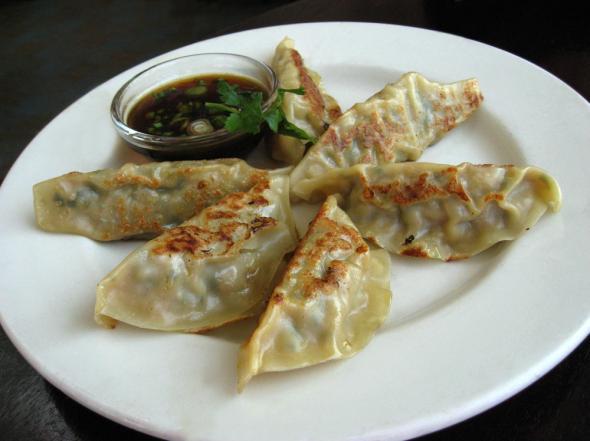As a white American, I’m in no position to expound on the correct way to make Chinese dumplings. Jiaozi, bao, mantou, shumai—I will enthusiastically eat these things if you invite me to dim sum, but I’m not an expert in making them. I am an expert, however, in attempting to reproduce my favorite restaurant dishes at home, and at imperiously endorsing my creations. So if you are a person who often orders dumplings at American Chinese restaurants but never makes them in your own kitchen, please read on for a better way to do things.
Homemade Americanized Chinese dumplings are way cheaper than the restaurant version, and you can make many, many times more of them than you get in a typical restaurant order. Plus, they are really not difficult. You can pleat them up all fancy if you’re so inclined, but shaping dumplings can be as easy as folding the wrappers in half and pressing the edges together with your fingers: It’s like sealing an envelope, but with water instead of saliva, and no risk of paper cuts.
The most readily available type of dumpling wrap is the wonton wrap, which contains egg (unlike traditional potsticker dough, which is made of only flour and water). So this recipe calls for readymade wonton wraps, which are delightfully doughy and chewy when cooked. (To anyone who protests that dumplings aren’t worth making unless you make the dough from scratch: Come on. Do you always make pasta from scratch, too?) The filling is a blend of cabbage and mushrooms boldly seasoned with ginger and soy sauce—so much so that you don’t need dipping sauce to make these taste good when you’re serving them (although adding a drizzle of Sriracha, like featuring Sam Smith on your dance single, is never a bad idea).
Wontons are usually deep-fried or served in soup, whereas potstickers are pan-fried with water or stock, which evaporates to cook the dumplings all the way through. Since these hybrid dumplings are vegetarian, you don’t have to worry about the threat of undercooked meat making you ill, so you can pan-fry them more efficiently, without added liquid. The result is a dumpling that’s crisp in parts, al dente in others, and never mushy.
Vegetarian Dumplings
Yield: 35 to 40 dumplings
Time: About 1½ hours
1 tablespoon sesame oil
¼ cup tablespoon canola or peanut oil
1 tablespoon minced fresh ginger
3 scallions, thinly sliced
3½ ounces shiitake mushrooms, trimmed and chopped
¼ large Savoy cabbage head (about 6 ounces), chopped
2 tablespoons soy sauce
35 to 40 wonton wraps
1. Put the sesame oil and 1 tablespoon of the canola oil in a large skillet over medium heat. When the oil is hot, add the ginger, scallions, and mushrooms, and cook until the mushrooms release their liquid, 3 to 5 minutes. Add the cabbage and ¼ cup water and cook, stirring occasionally, until the cabbage is very soft, about 20 minutes. Add the soy sauce and cook until it reduces to a glaze, 2 to 3 minutes, then remove from the heat.
2. Fill a small bowl with water, and lay a wonton wrap on a clean work surface. Use your fingers to lightly wet two adjacent edges of the wonton wrap, then put a heaping teaspoon of the cabbage mixture in the center of the wrap. Fold the wrap over to form a triangle, and press to adhere the wet edges to the dry edges. Repeat with the remaining wonton wraps and filling.
3. Put the remaining 3 tablespoons canola oil in a large skillet over medium-high heat. When it’s hot, add a single layer of dumplings and cook until golden brown on the bottom, 2 to 3 minutes, then turn and cook until lightly browned on the other side, another 2 to 3 minutes. Drain on paper towels, and repeat with the remaining dumplings. Serve hot or warm.
Previously in You’re Doing It Wrong:
Cheese
Ramen
Spinach
Stir-Fry
Broccoli
Channa Masala
Carrots
